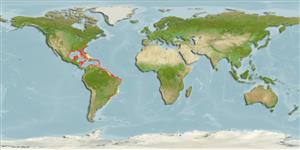Common names from other countries
Environment: milieu / climate zone / depth range / distribution range
Ecologia
; intervalo de profundidade 0 - 101 m (Ref. 83435). Tropical
Western Atlantic.
Length at first maturity / Tamanho / Peso / Idade
Maturity: Lm ? range ? - ? cm Max length : 3.5 cm DL macho/indeterminado; (Ref. 83435)
Maximum depth from Ref. 104365. In Belize, it was found in a submarine cave near Columbus Cay (Ref. 87209). Epibiotic, sessile, on hard substrate (Ref. 104365).
Life cycle and mating behavior
Maturidade | Reprodução | Desova | Ovos | Fecundidade | Larvas
Members of the class Bivalvia are mostly gonochoric, some are protandric hermaphrodites. Life cycle: Embryos develop into free-swimming trocophore larvae, succeeded by the bivalve veliger, resembling a miniature clam.
Gischler, E. and R.N. Ginsburg. 1996. (Ref. 86352)
Categoria na Lista Vermelha da IUCN (Ref. 130435)
Categoria CITES (Ref. 108899)
Not Evaluated
Not Evaluated
Utilização humana
| FishSource |
Ferramentas
Mais informação
Idade/Tamanho
Crescimento
Comprimento-peso
Comprimento-comprimento
Morfologia
Larvas
Abundância
Fontes da internet
Estimates based on models
Preferred temperature
(Ref.
115969): 21.8 - 27.9, mean 24.8 (based on 424 cells).
Categoria de preço
Unknown.
